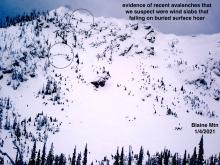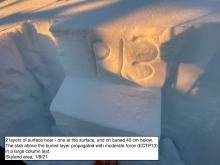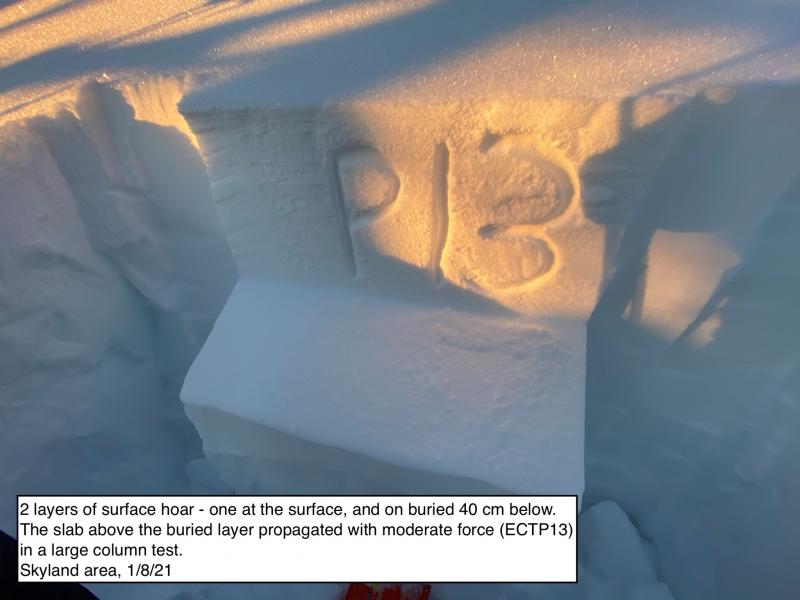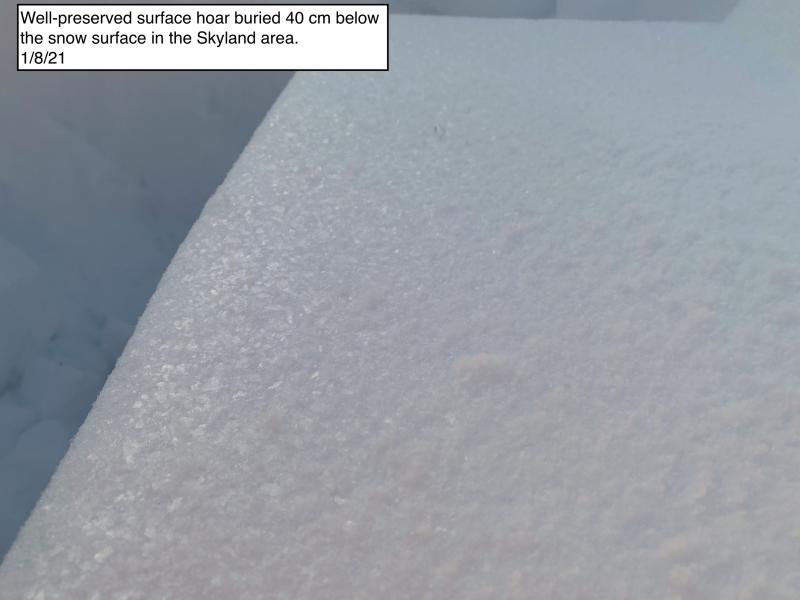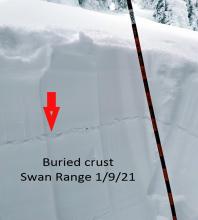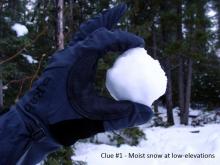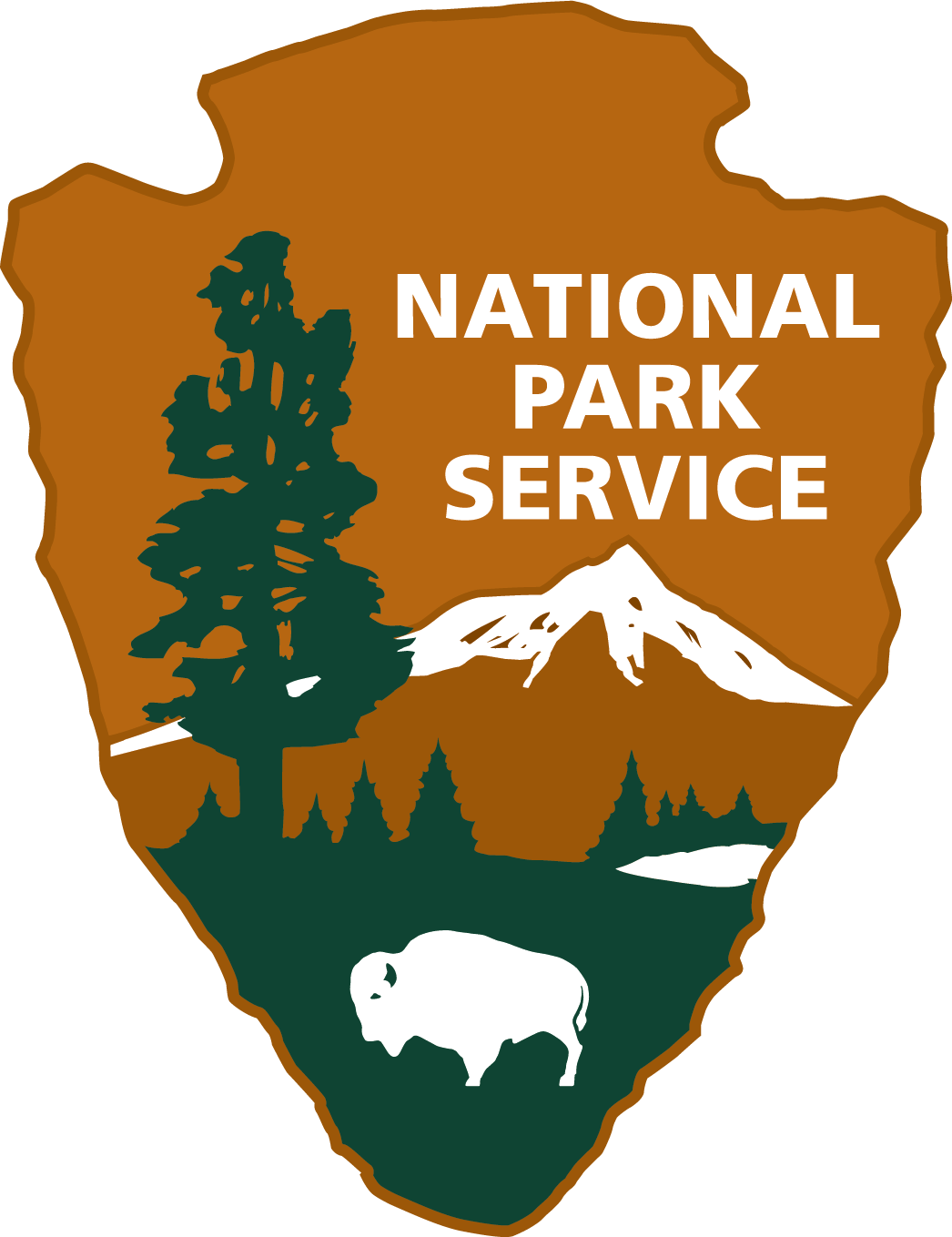| Sunday | Sunday Night | Monday | |
|---|---|---|---|
| Cloud Cover: | Mostly Cloudy | Mostly Cloudy | Mostly Cloudy |
| Temperatures: | 32 to 37 deg. F. | 23 to 28 deg. F. | 33 to 40 deg. F. |
| Wind Direction: | South | Southwest | Southwest |
| Wind Speed: | 5 to 15, G20 | 5 to 15 | 10 to 15, G25 |
| Snowfall: | 1 to 3" in. | 1 to 3" in. | 0 to 1" in. |
| Snow Line: | 4500' | 4500' | 5000' |
Flathead Range and Glacier National Park
How to read the forecast
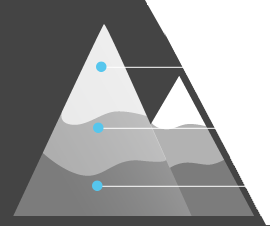
3. Considerable
?
Above 6500 ft.
2. Moderate
?
5000-6500 ft.
2. Moderate
?
3500-5000 ft.
- 1. Low
- 2. Moderate
- 3. Considerable
- 4. High
- 5. Extreme
-
Type ?
-
Aspect/Elevation ?
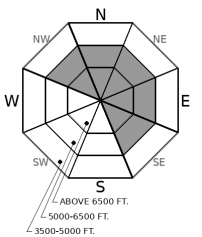
-
Likelihood ?CertainVery LikelyLikelyPossible
 Unlikely
Unlikely -
Size ?HistoricVery LargeLargeSmall

Several persistent slabs ran during yesterday's warm-up (Example A, Example B). One was large enough to snap trees. Observers yesterday also noted rumbling collapses and shooting cracks. These instabilities are hit or miss, the product of facets and faceted crusts from the March dryspell, that are now buried 2 to 3+ feet deep. The bulk of persistent slab activity this week has been on the northeast quadrant of the compass above 5,800': that is where weak layers were preserved and slab formation was aided by larger snow totals or wind loading. Slab activity this week continues to exhibit unusual behavior: Slabs are failing after multiple people have already crossed the slope (In other words, tracks on a slope aren't a sign of stability). They have surprised people with limited feedback prior to releasing (In other words, a lack of pit results or collapses isn't a guarantee). They have been remotely triggered, wrapped across confining terrain features, and released lower-than-usual slope angles (In other words, recalibrate your safe zones). The most reliable way to avoid the problem is by riding on slopes angles less than 30 degrees. You can reduce your risk with careful snowpack assessments and choosing aspects or elevations where the problem has been absent so far.
-
Type ?
-
Aspect/Elevation ?

-
Likelihood ?CertainVery LikelyLikelyPossible
 Unlikely
Unlikely -
Size ?HistoricVery LargeLargeSmall

Today's rain/snow line is expected to rise to about 4500'. Rain on snow or warming temperatures will destabilize the snow surface in very steep terrain, causing pinwheels, rollerballs, and loose wet sluffs. Pay attention for changing contionns and be careful around terrain traps such as creek beds or gullies at low elevations today. You can avoid loose wet sluffs by moving towards colder snow or lower angle terrain.
All of our forecasters have made comments this week about how scary or challenging the snowpack is right now, and we have been selecting more conservative terrain than we normally do on our field outings. I migrated to NW Montana after six years of forecasting in Colorado. It seems this week’s snowpack has migrated from Colorado as well. Scary persistent slabs are the norm for Colorado: It’s common for us to see bowls rip out after a dozen riders crossed the slope. Or hear about groups that trigger slabs while walking along a ridge or underneath the slope. And oftentimes, the snowpack “feels good”. The slabs themselves are topped by soft powder and feel right side up – they don’t communicate their hidden instabilities from the surface of the snowpack. Scary, yes, though we also felt comfortable navigating the mountains day-in and day out in Colorado by deploying two strategies: conservative terrain selection and patience. Weak layers will heal, but the several persistent slabs that ran yesterday are clear evidence that the wounds left by March’s dry spell need more time. And you might have to recalibrate your perception of conservative terrain, because we have seen several persistent slabs this week pull into slope angles as low as 31 or 32 degrees.
Stability tests can be a helpful tool for diagnosing the problem, but you need to understand there is a high amount of spatial variability to our current problem. This is because previous winds, sun, and rain have all had a role in altering where the weak layers are, and where they aren’t. The slabs themselves change properties too, based on differences in snowfall and wind loading. For example, this week I have looked at two fresh persistent slabs: one that we remotely triggered and one that ran less than an hour before we got to the crown. In both cases, my snow pack tests that day did not clue me into the instability. Slab and weak layer properties can change dramatically – over a matter of a few yards or a few basins. The snowmobilers in McGinnis Creek reported no cracking or collapsing prior to seeing the natural slide run on Standard Peak.
End of Season Announcement
Today is our last daily forecast of the season. We will update the website with a spring travel advisory by tomorrow afternoon. Despite the challenging and unusual conditions right now, we don't have the financial resources to extend our operating season. I want to applaud all of our forecast staff: Blase, Clancy, and Cam, for their tireless dedication to keeping you informed this season. Late nights spent recording obs or editing photo/media, early mornings spent stressing on avalanche concerns, and a lot of digging and hunting for instabilities, even on their days off. You can thank them by continuing to submit your own observations into the offseason and carrying on our mission of avalanche safety as a larger community.
A weak disturbance will bring a few inches of snow to the region later today and tonight. Convective activity means we'll see hit or miss snow squalls and graupel, along with erratic winds this afternoon. We'll continue on our warming trend today with the rain/snow line creeping upwards through the day and into tomorrow.
This forecast applies only to backcountry areas outside established ski area boundaries. The forecast describes general avalanche conditions and local variations always occur. This forecast expires at midnight on the posted day unless otherwise noted. The information in this forecast is provided by the USDA Forest Service who is solely responsible for its content.



